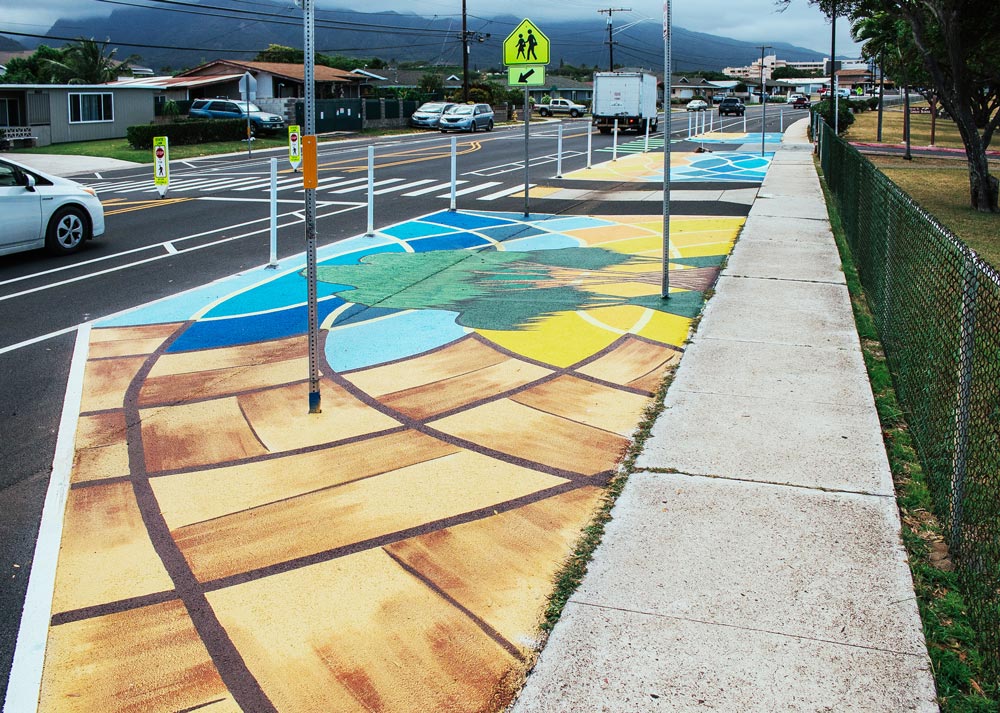
“It was our goal to stretch the limits of scope and scale of this quick-build to showcase what is possible in a short amount of time when public agencies and the community come together. We are incredibly pleased with what we were able to pull together as a team in such a short period of time.”
Mike Packard
SSFM Project Manager
“Community outreach was important to this project, but we faced major challenges as planning took place during the height of the COVID-19 pandemic. To combat this, our team developed a virtual survey and distributed it widely among the community. We also meet virtually on a regular basis with the Lihikai Elementary School faculty to gather input on the proposed improvements and keep them apprised as the project progressed.”
Abbey Seitz
SSFM Planner
“We received so many great proposals. Matthew’s proposal stood out for his comprehensive approach to engage the public, strong project management experience, and for his personal connection with the project objectives.”
Lauren Armstrong
Executive Director
Maui MPO
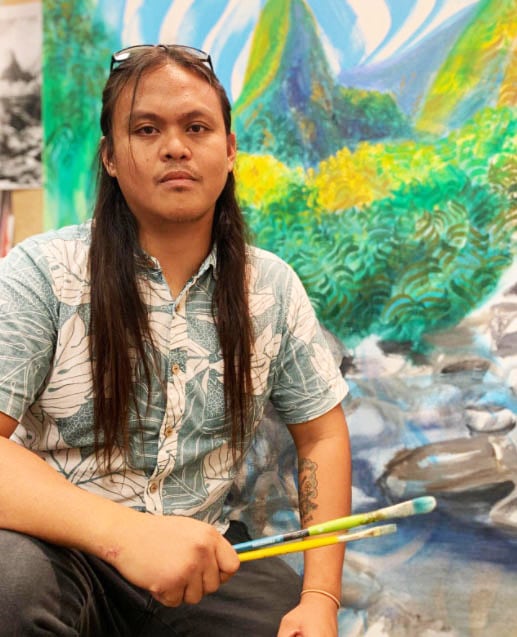
Matthew Agcolicol
Maui Artist
“My grandfather served as a crossing guard helping Lihikai Elementary students at this same intersection. I remember his high-visibility vest which inspired me to be more aware of road safety concerns, especially after the tragic death of a student who was hit by a vehicle while crossing the street,” Agcolicol said. “I am grateful that my art can have a positive impact in creating safer roads.”
Papa Avenue – Māʻalo Street Quick Build Demonstration Project
SSFM HAS HAD THE PRIVILEGE OF PARTICIPATING IN ONE OF MAUI’S FIRST QUICK-BUILD STREET PROJECTS. QUICK-BUILD INSTALLATIONS MAKE ROADWAYS SAFER FOR PEDESTRIANS AND BICYCLISTS THROUGH A PLACEMAKING, COMMUNITY-DRIVEN PROCESS.
Quick-Build projects serve as a response to the lengthy, and often expensive, process of planning, designing, and building transportation infrastructure. Simple traffic calming measures can often take over five years from approval to construction. Quick-Build projects employ semi-permanent transportation materials that can be installed rapidly. These low-cost materials, such as paint, signage, and delineators, are used to help the community reimagine how roadways look and function.
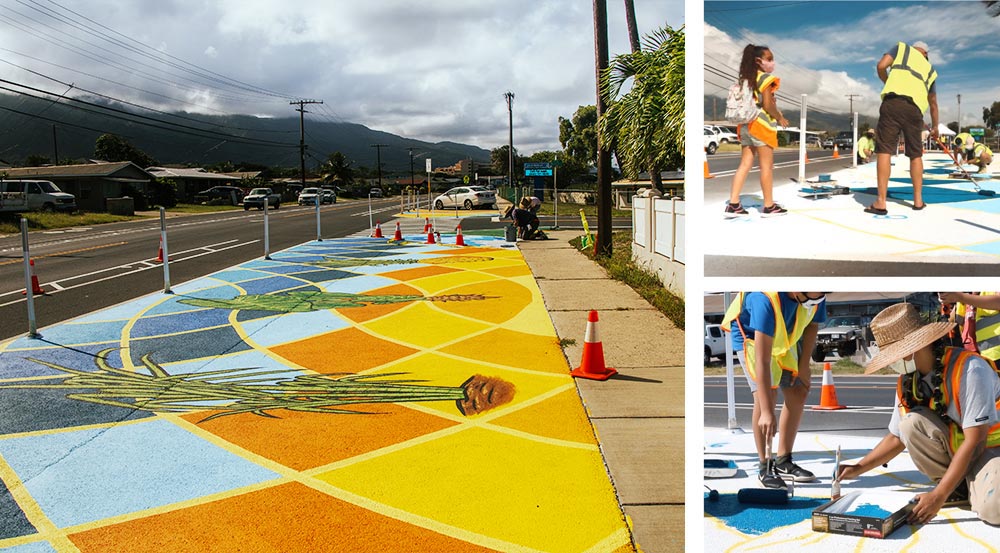
The Project
In the summer of 2020, at the height of the COVID-19 pandemic, the State Department of Health, Maui Metropolitan Planning Organization, Hawaiʻi Public Health Institute’s Healthy Eating + Active Living Coalition, and the County of Maui joined forces to solicit funding and undertake the Quick-Build demonstration project at Papa Avenue and Māʻalo Street in Kahului. SSFM International was selected to steward the project from its inception through implementation. The project location is a busy intersection fronting Lihikai Elementary School.
The Papa Avenue – Māʻalo Quick-Build Project will enable safer access and use for pedestrians, bicyclists, and motorists while also creating a sense of place through locally focused street art. The final product proposes to be a vibrant demonstration of the Complete Streets concept. It will also advance Maui’s Vision Zero goal of eliminating all traffic fatalities by 2040.
The Improvements
Key components of the Papa Ave – Māʻalo Street Quick-Build project include enhanced bike and pedestrian crossings, improved sight lines, back-in angled parking, and traffic calming features. The back-in angled parking, a proven safety enhancement, is the first on Maui. A dramatic street art composition by Maui artist Matthew Agcolicol is the focal point of the improvements and provide a gateway to Lihikai Elementary School. Matthew was selected from a host of proposals, for his artwork that honors the area’s rich history, cultural diversity, and the Lihikai Elementary School mascot, the Surfer.
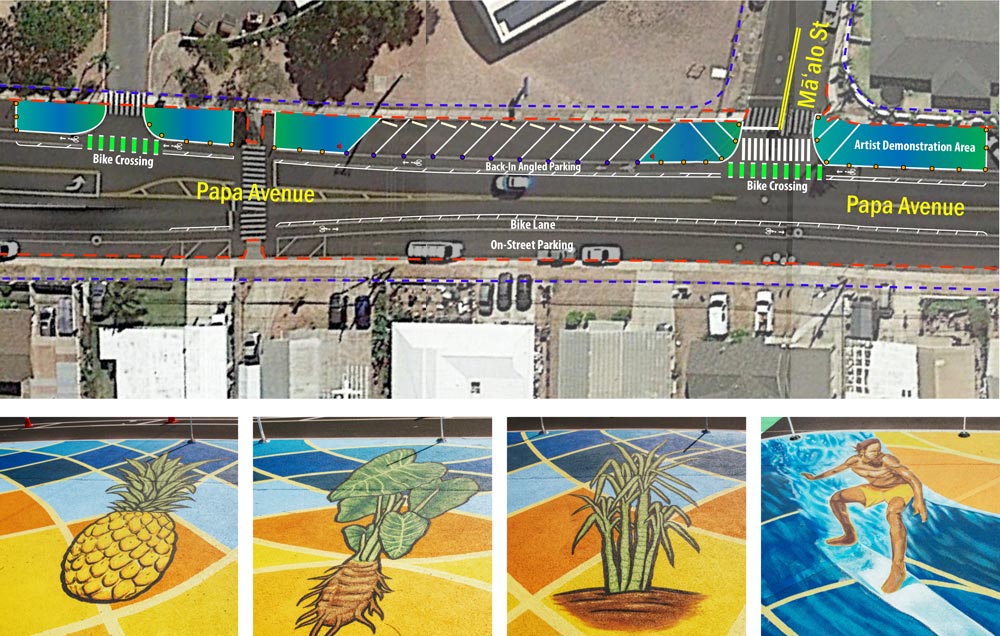
Public Engagement
As part of the process, nearly 200 residents and Lihikai school staff, teachers and families participated in a survey, sharing their experiences while navigating the Papa Avenue – Māʻalo Street intersection. Public input was instrumental in the project design and street beautification, and will also inform future improvements by the County. From the survey feedback we learned:
• People drive too fast through the area causing it to be unsafe.
• Walking was relatively safe at and near the intersection.
• Biking was considered relatively unsafe at and near the intersection.
• Back-in angled parking was generally viewed as positive but it is clear people needed to become familiar with how to use it.
• Protected bike lanes, bike crossings, and artist demonstration areas received over 90% support.
• Hawaiian cultural values and history, as well as the Lihikai school surfer mascot imagery, were strong preferences for the street painting.
Results
Just as its name implies, Quick-Build projects happens quickly. The Papa Ave – Māʻalo Street project was initiated in August, 2020. Planning, artist selection, community surveys, project design and documentation were completed within eight months. Implementation begun in March, 2021 and completed in April, 2021.
Maui County Mayor Michael Victorino, Councilmember Tasha Kama, State Representative Troy Hashimoto, Lihikai Elementary School Principal Barbara Ouva Tavares, and nearly twenty community volunteers joined the project team to celebrate the project’s opening and assist with painting the street murals.
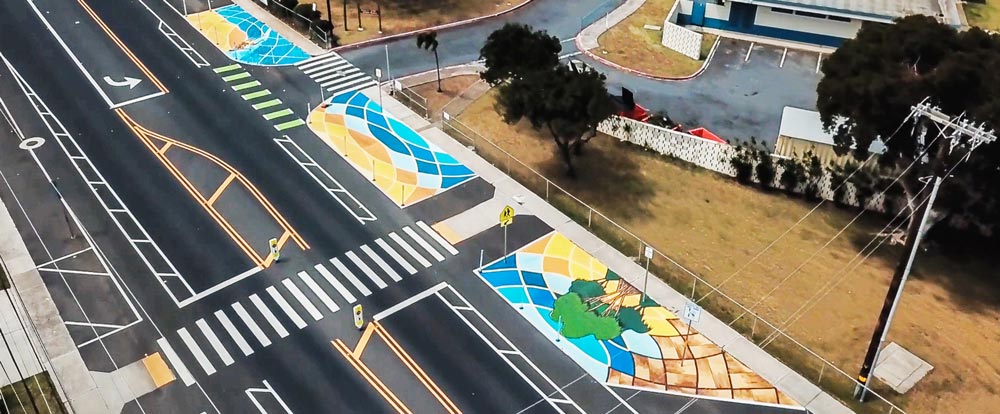
Quick-Build projects offer the opportunity to gauge the effectiveness of different transportation improvements prior to implementing them through full reconstruction. These improvements can then be adjusted, changed or removed in response to real world feedback. Through this initial effort, the public will become more familiar with, and accepting of, the changes proposed as a part of a larger project that aims to reconstruct a larger segment of road.
Based on data collection before and after project implementation, average automobile speeds reduced by 1-2 mph during the weekday morning/afternoon peak hours, near the Papa Avenue – Māʻalo Street intersection. This project received positive response from the community, as well as policy makers, and underscored the need for additional projects that could be implemented with a small budget and compressed timeline.
Photos by Kelsey Herold/Groovy Awapuhi Photography
Papa Avenue–
Māʻalo Street Quick Build Demonstration Project

SSFM HAS HAD THE PRIVILEGE OF PARTICIPATING IN ONE OF MAUI’S FIRST QUICK-BUILD STREET PROJECTS. QUICK-BUILD INSTALLATIONS MAKE ROADWAYS SAFER FOR PEDESTRIANS AND BICYCLISTS THROUGH A PLACEMAKING, COMMUNITY-DRIVEN PROCESS.
Quick-Build projects serve as a response to the lengthy, and often expensive, process of planning, designing, and building transportation infrastructure. Simple traffic calming measures often take over five years from approval to construction. Quick-Build projects employ semi-permanent transportation materials that can be installed rapidly. Low-cost materials, such as paint, signage, and delineators, are used to help the community reimagine how roadways look and function.

” It was our goal to stretch the limits of scope and scale of this quick-build to showcase what is possible in a short amount of time when public agencies and the community come together. We are incredibly pleased with what we were able to pull together as a team in such a short period of time.”
Mike Packard
SSFM Project Manager
The Project
In the summer of 2020, at the height of the COVID-19 pandemic, the State Department of Health, Maui Metropolitan Planning Organization, Hawaiʻi Public Health Institute’s Healthy Eating + Active Living Coalition, and the County of Maui joined forces to solicit funding and undertake the Quick-Build demonstration project at Papa Avenue and Māʻalo Street in Kahului. SSFM International was selected to steward the project from its inception through implementation. The project location is a busy intersection fronting Lihikai Elementary School.
The Papa Avenue–Māʻalo Quick-Build Project will enable safer access and use for pedestrians, bicyclists, and motorists while also creating
a sense of place through locally focused street art. The final project
is a vibrant demonstration of the Complete Streets concept. It will
also advance Maui’s Vision Zero goal of eliminating all traffic fatalities by 2040.
The Improvements
Key components of the Papa Ave–Māʻalo Street Quick-Build project include enhanced bike and pedestrian crossings, improved sight lines, back-in angled parking, and traffic calming features. The back-in angled parking, a proven safety enhancement, is the first on Maui. A dramatic street art composition by Maui artist Matthew Agcolicol is the focal point of the improvements and provide a gateway to Lihikai Elementary School. Matthew was selected from a host of proposals, for his artwork that honors the area’s rich history, cultural diversity, and the Lihikai Elementary School mascot, the Surfer.

“Community outreach was important to this project, but we faced major challenges as planning took place during the height of the COVID-19 pandemic. To combat this, our team developed a virtual survey and distributed it widely among the community. We also meet virtually on a regular basis with the Lihikai Elementary School faculty to gather input on the proposed improvements and keep them apprised as the project progressed.”
Abbey Seitz
SSFM Planner
Public Engagement
As part of the process, nearly 200 residents and Lihikai school staff,
teachers and families participated in a survey, sharing their experiences while navigating the Papa Avenue–Māʻalo Street intersection. Public input was instrumental in the project design and street beautification, and will also inform future improvements by the County.
From the survey feedback we learned:
- People drive too fast through the area causing it to be unsafe.
- Walking was relatively safe at and near the intersection.
- Biking was considered relatively unsafe at and near the intersection.
- Back-in angled parking was generally viewed as positive but it is clear people needed to become familiar with how to use it.
- Protected bike lanes, bike crossings, and artist demonstration areas received over 90% support.
- Hawaiian cultural values and history, as well as the Lihikai school surfer mascot imagery, were strong preferences for the street painting.
“We received so many great proposals. Matthew’s proposal stood out for his comprehensive approach to engage the public, strong project management experience, and for his personal connection with the project objectives.”
Lauren Armstrong
Executive Director
Maui MPO

Matthew Agcolicol
Maui Artist
“My grandfather served as a crossing guard helping LihikaiElementary students at this same intersection. I remember his high-visibility vest which inspired me to be more aware of road safety concerns, especially after the tragic death of a student who was hit by a vehicle while crossing the street. I am grateful that my art can have a positive impact in creating safer roads.”
Results
Just as its name implies, Quick-Build projects happens quickly. The Papa Ave–Māʻalo Street project was initiated in August, 2020. Planning, artist selection, community surveys, project design and documentation were completed within eight months. Implementation begun in March, 2021 and completed in April, 2021.
Maui County Mayor Michael Victorino, Councilmember Tasha Kama, State Representative Troy Hashimoto, Lihikai Elementary School Principal Barbara Ouva Tavares, and nearly twenty community volunteers joined the project team to celebrate the project’s opening and assist with painting the street murals.
Quick-Build projects offer the opportunity to gauge the effectiveness of different transportation improvements prior to implementing them through full reconstruction. These improvements can then be adjusted, changed or removed in response to real world feedback. Through this initial effort, the public will become more familiar with, and accepting of, the changes proposed as a part of a larger project that aims to reconstruct a larger segment of road.
Based on data collection before and after project implementation, average automobile speeds reduced by 7% during the weekday morning/afternoon peak hours, near the Papa Avenue–Māʻalo Street intersection. This project received positive response from the community, as well as policy makers, and underscored the need for additional projects that could be implemented with a small budget and compressed timeline.

Photos by Kelsey Herold/Groovy Awapuhi Photography
